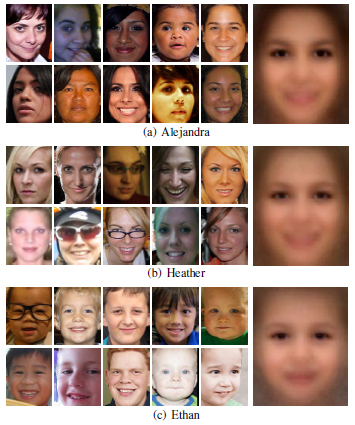What's in a Name? First Names as Facial Attributes |
|
|
|
|
|
When you hear a first name like "Bob", do you imagine a face with a certain appearance? In this work, we study the statistical relationships between names and faces. In the Figure, face examples of 2 female and 1 male names and their average faces are computed from 280 aligned faces. Comparing the average faces, Alejandra (often Hispanic) has darker skin and hair than the average face of Heather (often Caucasian). In contrast, Ethan (a popular boy's name in recent years) is much younger looking. We learn the connection between faces and names, and use our classifiers for a variety of tasks. |
|
|
|
|
|
Abstract This paper introduces a new idea in describing people using their first names, i.e., the name assigned at birth. We show that describing people in terms of similarity to a vector of possible first names is a powerful description of facial appearance that can be used for face naming and building facial attribute classifiers. We build models for 100 common first names used in the United States and for each pair, construct a pairwise first-name classifier. These classifiers are built using training images downloaded from the internet, with no additional user interaction. This gives our approach important advantages in building practical systems that do not require additional human intervention for labeling. We use the scores from each pairwise name classifier as a set of facial attributes. We show several surprising results. Our name attributes predict the correct first names of test faces at rates far greater than chance. The name attributes are applied to gender recognition and to age classification, outperforming state-of-the-art methods with all training images automatically gathered from the internet. |
|
Huizhong Chen |
|
|
|
Press
|
|
